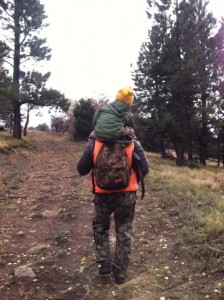
20 Oct Fall Sunday: The Tradition of Hunting
 When most people think about hunting, they picture a bunch of dudes in camouflage pants and fluorescent orange vests, drinking cans of beer and driving around in oversized trucks. But there is more to it than that, and the faces of people who hunt are a lot more diverse than you might think.
When most people think about hunting, they picture a bunch of dudes in camouflage pants and fluorescent orange vests, drinking cans of beer and driving around in oversized trucks. But there is more to it than that, and the faces of people who hunt are a lot more diverse than you might think.
I expected to be the only woman in my hunter’s education class a few years ago. After 15 years of being a quasi-vegetarian, with the only “meat” I ate being fish because it lived in the wild, I had decided to start eating game. It was a decision I took seriously, and I thought it was important to be connected with my food source. I reasoned that if I was going to eschew industrially raised meat and start eating wild game, I should be able to hunt and kill it, too. Eight of the ten students in the class were women, seeking to empower themselves in the same way, looking to eat a more healthy and natural diet.
Guns were the big hurdle for me. I had never even held a gun, and my hands shook and my stomach tightened when I grasped one for the first time. I wasn’t sure I could do it, but I knew it was important to be able to shoot properly and safely. Even this year, in my fourth season, and after harvesting two elk, I still felt timid with my rifle. I called my friend and asked him to help me sight-in, and he invited me down to his family house, the 40-acre property where he had grown up and learned to hunt.
His 4-year-old son beamed with excitement and pride. “Are you going hunting, Daddy?” he asked. “Not yet, we’re just getting ready,” he said. “Go inside while we’re shooting.”
He set up the target and handled his gun expertly, demonstrating his many years of experience. It struck me that he had once been the young child waiting inside while his father and uncle sighted in their rifles on this same land. And that when he got older, his father had taken him and his brother through all these same steps. That he had learned all of his backcountry wisdom that way, how to step carefully and soundlessly through the woods, stopping to listen for animals walking through the forest. That his father had passed down the knowledge of what a cow elk calling, or a male elk bugling, sounds like. What elk smell like. How to determine the difference between animal tracks and “sign” or scat, how fresh it is showing how close the animal might be. How the phases of the moon affect the way the animals move around.
For him, hunting is a tradition, and a part of his life in the West. He lost his father when he was a young man, and he honors his memory every autumn season, carrying his memory as he hunts. He dresses his animal and butchers it in the same shed as his father did. He and his family have been harvesting and eating the elk that live around this property for decades, and some day his young son—and maybe even his daughter—will employ these same traditions. For me, this is all new, the quiet walking, the careful inspection of sight, sound, and smell in the woods. I didn’t grow up with the same wisdom or deep respect for nature, but I am glad to be indoctrinated now. And I hope to be able to pass on at least some of these lessons to my children, so that they can be connected with the outdoors, whether or not they choose to hunt.


Sorry, the comment form is closed at this time.